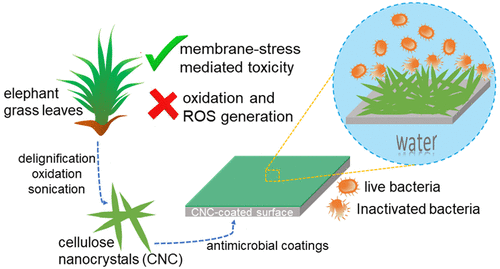当前位置:
X-MOL 学术
›
ACS Sustain. Chem. Eng.
›
论文详情
Our official English website, www.x-mol.net, welcomes your
feedback! (Note: you will need to create a separate account there.)
Physical Membrane-Stress-Mediated Antimicrobial Properties of Cellulose Nanocrystals
ACS Sustainable Chemistry & Engineering ( IF 7.1 ) Pub Date : 2021-02-11 , DOI: 10.1021/acssuschemeng.0c08317 Victor T. Noronha 1, 2 , Camilla H. M. Camargos 3 , Jennifer C. Jackson 1 , Antonio G. Souza Filho 4 , Amauri J. Paula 2 , Camila A. Rezende 3 , Andreia F. Faria 1
ACS Sustainable Chemistry & Engineering ( IF 7.1 ) Pub Date : 2021-02-11 , DOI: 10.1021/acssuschemeng.0c08317 Victor T. Noronha 1, 2 , Camilla H. M. Camargos 3 , Jennifer C. Jackson 1 , Antonio G. Souza Filho 4 , Amauri J. Paula 2 , Camila A. Rezende 3 , Andreia F. Faria 1
Affiliation

|
Cellulose nanocrystals (CNCs) have emerged as a sustainable nanomaterial for several environmental applications, including the development of novel antimicrobial agents. Although previous studies have reported antibacterial activity for CNCs, their toxicity mechanism to bacterial cells is still unknown. Here, we investigate the toxicity of CNCs dispersed in water and coated surfaces against Escherichia coli cells. CNC-coated surfaces were able to inactivate approximately 90% of the attached E. coli cells, confirming potential of CNCs to be applied as a sustainable and cost-effective antibiofouling nanomaterial. The toxicity of CNCs in a suspension was concentration-dependent, and an inhibitory concentration (IC50%) of 200 μg/mL was found. Glutathione and 2′,7′-dichlorodihydrofluorescein diacetate (H2DCFA) assays were conducted to evaluate the role of oxidative stress in the CNC toxicity mechanism. Our findings showed that oxidative stress has no significant effect on the antimicrobial activity of CNC. In contrast, scanning electron microscopy (SEM) images and a leakage assay performed with dye-encapsulated phospholipid vesicles indicated that CNCs inactivate bacteria by physically damaging their cell membrane. CNC interaction with dye-encapsulated vesicles resulted in a dye leakage corresponding to 43% of the maximum value, thus confirming that contact-mediated membrane stress is the mechanism governing the toxicity of CNCs to bacteria cells.
中文翻译:

纤维素纳米晶体的物理膜应力介导的抗菌性能。
纤维素纳米晶体(CNC)已经成为一种可持续的纳米材料,可用于多种环境应用,包括新型抗菌剂的开发。尽管以前的研究已经报道了对CNCs的抗菌活性,但是它们对细菌细胞的毒性机制仍然未知。在这里,我们研究了分散在水和涂层表面的CNCs对大肠杆菌细胞的毒性。经过CNC涂层处理的表面能够使大约90%的附着的大肠杆菌细胞失活,从而确认了将CNCs用作可持续且具有成本效益的抗生物污垢纳米材料的潜力。悬浮液中CNCs的毒性取决于浓度,并且抑制浓度(IC 50%发现)为200μg/ mL。进行了谷胱甘肽和2',7'-二氯二氢荧光素二乙酸酯(H 2 DCFA)分析,以评估氧化应激在CNC毒性机制中的作用。我们的发现表明,氧化应激对CNC的抗菌活性没有显着影响。相比之下,扫描电子显微镜(SEM)图像和用染料包裹的磷脂囊泡进行的渗漏分析表明,CNC通过物理破坏细胞膜使细菌失活。CNC与染料包裹的囊泡的相互作用导致染料泄漏,相当于最大值的43%,因此证实接触介导的膜应力是控制CNC对细菌细胞毒性的机制。
更新日期:2021-03-01
中文翻译:

纤维素纳米晶体的物理膜应力介导的抗菌性能。
纤维素纳米晶体(CNC)已经成为一种可持续的纳米材料,可用于多种环境应用,包括新型抗菌剂的开发。尽管以前的研究已经报道了对CNCs的抗菌活性,但是它们对细菌细胞的毒性机制仍然未知。在这里,我们研究了分散在水和涂层表面的CNCs对大肠杆菌细胞的毒性。经过CNC涂层处理的表面能够使大约90%的附着的大肠杆菌细胞失活,从而确认了将CNCs用作可持续且具有成本效益的抗生物污垢纳米材料的潜力。悬浮液中CNCs的毒性取决于浓度,并且抑制浓度(IC 50%发现)为200μg/ mL。进行了谷胱甘肽和2',7'-二氯二氢荧光素二乙酸酯(H 2 DCFA)分析,以评估氧化应激在CNC毒性机制中的作用。我们的发现表明,氧化应激对CNC的抗菌活性没有显着影响。相比之下,扫描电子显微镜(SEM)图像和用染料包裹的磷脂囊泡进行的渗漏分析表明,CNC通过物理破坏细胞膜使细菌失活。CNC与染料包裹的囊泡的相互作用导致染料泄漏,相当于最大值的43%,因此证实接触介导的膜应力是控制CNC对细菌细胞毒性的机制。











































 京公网安备 11010802027423号
京公网安备 11010802027423号